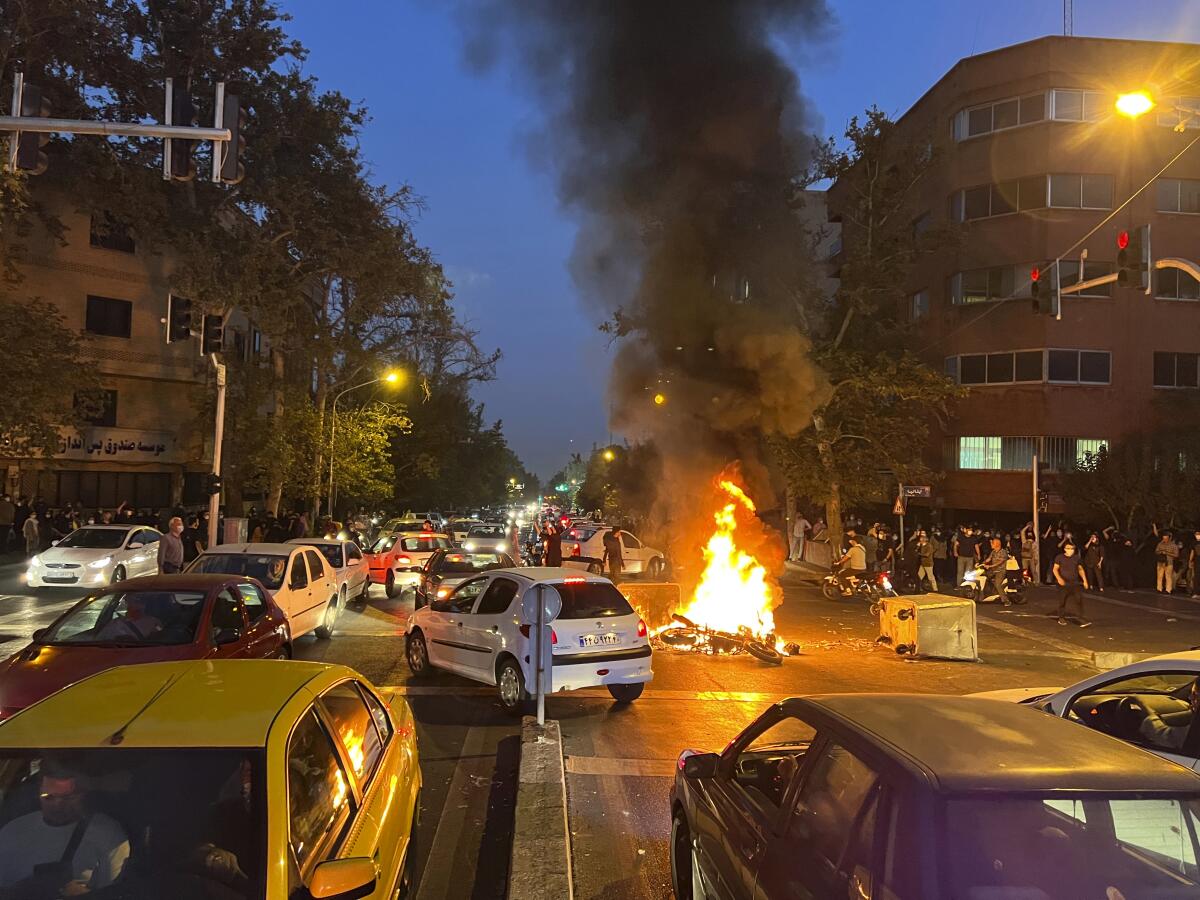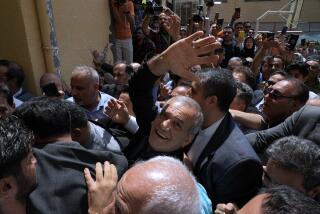In protests over death of Mahsa Amini, internet is key to planning. Can Iran block access?

- Share via
TEHRAN — Iran’s anti-government protests, which were sparked by the death of a young woman in police custody, have gone viral, and then some.
The internet is an essential tool for these demonstrators. For more than a week, millions have shared wrenching videos and vivid online images of confrontations between protesters and Iranian authorities.
They’ve topped news broadcasts and ricocheted across the globe.
The hard-line government in Tehran has deployed digital trackers and waged an all-out media war against protesters and their supporters — a strategy it used in 2019 to quash protests in just three days. Back then, authorities took control of the internet and unleashed a violent crackdown that resulted in thousands of arrests and as many as 1,500 deaths.
This time is different. The protests are well into their second week and show little sign of waning.
They began Sept. 16 after the death of 22-year-old Mahsa Amini, who allegedly had violated the country’s conservative dress code, and quickly tapped into wider discontent with government corruption and declining living standards. Officials say 41 people have been killed, including demonstrators and police, and 1,200 arrested, while rights groups claim much higher figures.
A key reason protesters have been able to keep the demonstrations going and maintain the world’s attention: They were ready to do battle in cyberspace.
“In 2019, everybody was shocked authorities could impose a massive internet shutdown, but this time many predicted it would happen,” said Mahbod, a 27-year-old student at Tehran’s Sharif University. Like others interviewed, he gave only his first name for fear of reprisals.
Hackers and tech experts worldwide have weighed in to help cyber-savvy activists organize, fight back and dominate in the digital domain — a key battleground that Iran’s leadership, more than ever, appears unable to control.
Hours after the protests began, internet monitor Netblocks reported a 33% loss in connectivity in Tehran, which later spread to other cities and provinces across Iran.
But activists quickly outmaneuvered the government, turning to Instagram and WhatsApp — some of the few social media sites still functioning — to call for demonstrations or set up meeting points. They started a hashtag under the Persian version of #Mahsa_Amini that was retweeted by some 30 million people despite the shutdown. It has reached more than 100 million users, making it the most retweeted hashtag in Twitter’s history, Iranian opposition outlets say.
Then on Wednesday, the government restricted access to most social media, curtailing it sharply between 4 p.m. and approximately 1 a.m., when most protests take place. Apple and Google Play stores are blocked to prevent people from installing Virtual Private Network (VPN) apps they could use to circumvent surveillance.
Still, Mahbod’s more tech-inclined friends at university share information on which software and settings to use; it’s not uncommon for people to have four or five different programs to switch between depending on the day and area.
“The VPNs we use are much more complex than they were a few years ago,” said Mehdi, a 39-year-old self-described computer geek from Tehran. “Cheap ones you need to switch every three or four days, but the more expensive ones with subscriptions work well.”
Help has also come from outside Iran’s borders. The tech collective Anonymous has hacked government websites, including that of Iran’s Supreme Leader Ayatollah Ali Khamenei. On Sunday, it doxxed members of parliament, releasing lawmakers’ phone numbers and other data.
Meanwhile, the U.S. Treasury Department on Friday eased sanctions by authorizing technology companies to offer “secure, outside platforms and services” to Iranian users.
“As courageous Iranians take to the streets to protest the death of Mahsa Amini, the United States is redoubling its support for the free flow of information to the Iranian people,” Deputy Secretary of the Treasury Wally Adeyemo said in a statement.
“With these changes, we are helping the Iranian people be better equipped to counter the government’s efforts to surveil and censor them,” the statement added.
Hours later, tech entrepreneur Elon Musk said that the Starlink satellite system, which relies on a low-Earth-orbit satellite network to offer broadband internet, was now activated in Iran.
Tehran soon blocked access to the Starlink website, and dummy activation links containing malware were planted in the Iranian Twittersphere in an apparent attempt to lure anti-government protesters.
Foreign Ministry spokesman Nasser Kanaani on Saturday said that by loosening communication-related sanctions but keeping up others, “America is seeking to advance its own goals against Iran with hypocrisy.”
He added that “attempts at violating the Iranian sovereignty will not go unanswered.”
Iranian tech experts working abroad have also joined the fray. Kooshiar Azimian, who heads the U.S.-based biotech company 310.ai and is a former Facebook engineer, regularly gives updates on his Instagram page on the latest method for accessing internet service in Iran.
Another U.S.-based Iranian computer scientist, Moshfegh Hamedani, has posted information on Twitter on how to bypass website filtering, and excoriated programmers working with the government.
A growing chorus of government officials is threatening punishment for those who take part in the unrest.
Iran’s hard-line judicial chief, Gholam Hossein Mohseni Ejehi, said in a visit to police headquarters this week that protesters, whom he described as rioters, were “the foot soldiers of the enemies of the Islamic Republic.” Echoing previous harsh statements by President Ebrahim Raisi, he declared that those who defy authorities would be shown “no leniency.”
Karim Sadjadpour of the Carnegie Endowment tweeted that the government wanted to restrict internet access “so it can repress people in the dark.”
The best way the United States and other Western allies can help Iranians, he wrote, is to keep the Iranian government from blocking access to the internet. Protesters’ best hope of effecting change, Sadjadpour said, lies in “connecting with one another and the outside world.”
Special correspondent Khazani reported from Tehran and Times staff writer Bulos from Beirut.
More to Read
Sign up for Essential California
The most important California stories and recommendations in your inbox every morning.
You may occasionally receive promotional content from the Los Angeles Times.









